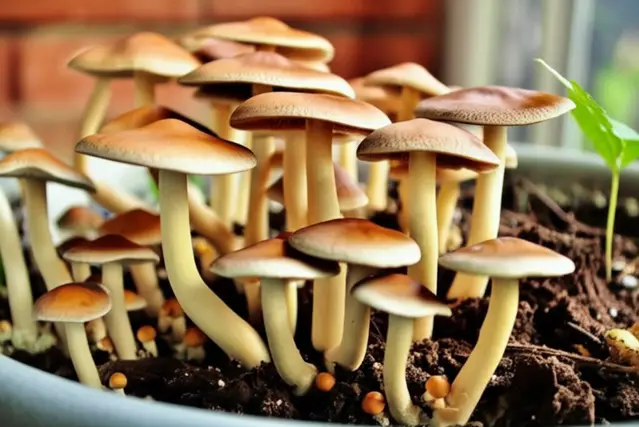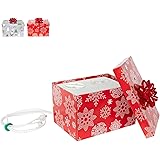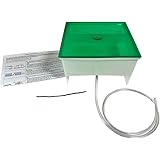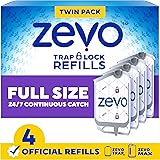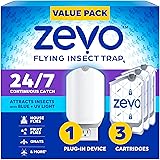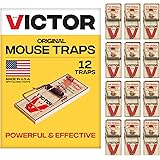Picture this: You’re admiring your thriving houseplant collection, a vibrant green oasis in your living room. You reach for the watering can, and then… BAM! A tiny mushroom (or a cluster of them) has sprouted in the soil of your beloved fiddle-leaf fig. Panic sets in. Is your plant doomed? Is your house about to be overrun by a fungal invasion?
Relax! While the sight of mushrooms in your houseplant can be alarming, it’s usually not a death sentence for your green friend. Let’s dive into why these unexpected guests appear, whether they’re harmful, and, most importantly, what you can do about it.
Understanding the Surprise: What Are Those Mushrooms?
Before you reach for the fungicide, it’s important to understand what you’re dealing with. Mushrooms are simply the fruiting bodies of fungi living in the soil. The bulk of the fungus, the mycelium, is a network of thread-like structures that live unseen in the soil. When conditions are right – usually warm, moist, and with plenty of organic matter – the mycelium sends up these mushrooms to reproduce and spread its spores. This doesn’t mean your plant is diseased; it simply means the soil environment is conducive to fungal growth.
The Role of Fungi in Your Houseplant’s Ecosystem
Fungi aren’t inherently bad. In fact, they play a vital role in healthy ecosystems. In nature, they decompose organic matter, releasing nutrients that plants can use. Some fungi even form symbiotic relationships with plant roots, helping them absorb water and nutrients more efficiently. This symbiotic relationship is called a mycorrhizal association. While the mushrooms themselves might be unwelcome, the presence of the fungus itself often indicates healthy, nutrient-rich soil, even if that soil is a bit *too* rich.
Why Mushrooms Appear: Understanding the Contributing Factors
So, what exactly creates the perfect conditions for mushrooms to pop up in your indoor garden? Here’s a breakdown of the most common culprits:
1. Excess Moisture: The Fungal Paradise
This is the number one reason mushrooms appear. Fungi thrive in moist environments. Overwatering your plants, especially during the dormant winter months, creates the ideal conditions for fungal growth. If the soil stays consistently wet, the mycelium will flourish and eventually produce mushrooms. Remember, most houseplants prefer to dry out slightly between waterings. Using a moisture meter can be a helpful tool to avoid overwatering.
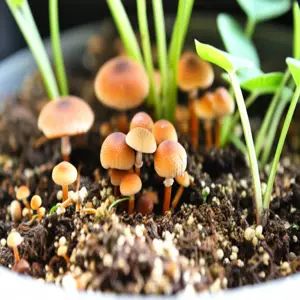
houseplant fungi
Current Trend: There’s a growing trend towards self-watering planters. While these can be convenient, they can also contribute to consistently moist soil, increasing the risk of mushrooms. Make sure to monitor the water reservoir carefully and allow the soil surface to dry out occasionally.
2. Rich Potting Mix: A Fungal Feast
Many commercially available potting mixes are rich in organic matter like peat moss, compost, and bark. While these materials are great for plant growth, they also provide a food source for fungi. The more organic matter in the soil, the more potential there is for fungal growth. Using a well-draining potting mix that’s not excessively rich in organic matter can help prevent mushroom growth. Consider mixes formulated specifically for houseplants.
Example: A potting mix high in peat moss retains a lot of moisture. If you’re prone to overwatering, this combination is a recipe for mushroom growth. A better option might be a mix containing perlite or vermiculite to improve drainage.
3. Poor Drainage: Trapped Moisture
Even if you’re not overwatering, poor drainage can keep the soil consistently moist. If the pot doesn’t have adequate drainage holes, or if the drainage holes are blocked, water will accumulate at the bottom of the pot, creating a breeding ground for fungi. Make sure your pots have drainage holes and that they’re not obstructed by pebbles or other materials. You should also avoid placing your potted plant directly on a saucer full of water. Empty the saucer after each watering to prevent the plant from sitting in standing water. Consider using a pot with feet or risers to improve air circulation around the base.
4. Poor Air Circulation: Stagnant Environment
Good air circulation helps the soil dry out more quickly, reducing the risk of fungal growth. Plants in tightly packed groups, or those in enclosed spaces with poor ventilation, are more susceptible to mushroom problems. Ensure your plants have adequate space around them to allow for air to circulate freely. You can also use a small fan to improve air circulation, especially in humid environments.
5. Decomposing Organic Matter: A Natural Food Source
As leaves and other organic matter decompose in the soil, they provide a food source for fungi. Dead leaves, fallen petals, or even stray food scraps that accidentally end up in the pot can contribute to fungal growth. Regularly remove any dead or decaying organic matter from the soil surface.
6. Spores in the Air: The Inevitable Arrival
Fungal spores are everywhere in the air. It’s impossible to completely eliminate them. They can enter your home through open windows, on your clothes, or even on the surface of new plants. While you can’t prevent spores from entering your home, you can control the conditions that allow them to thrive.
Identifying the Mushrooms: Are They Harmful?
Identifying the specific type of mushroom growing in your houseplant’s soil can be challenging. Many mushroom species look very similar, and accurate identification often requires microscopic examination. However, in most cases, the mushrooms that appear in houseplants are harmless to the plants themselves. They’re simply breaking down organic matter in the soil. The bigger concern is their potential toxicity to humans and pets.
Common Types of Mushrooms Found in Houseplant Soil
While a definitive identification is difficult without expert help, here are some of the more common types of mushrooms that might appear in your houseplant soil:
| Mushroom Type | Description | Potential Harm |
|---|---|---|
| Leucocoprinus birnbaumii (Flowerpot Parasol) | Small, yellow mushrooms with a conical cap and a ring on the stem. | Mildly toxic if ingested; may cause gastrointestinal upset. |
| Peziza species (Cup Fungi) | Cup-shaped fungi that can range in color from brown to orange. | Generally considered harmless to plants, but some species may be mildly toxic if ingested. |
| Various Saprophytic Species | Small, brownish or whitish mushrooms that appear in clusters. | Toxicity varies; it’s best to assume they are not safe to eat. |
Important Note: Never consume any mushrooms growing in your houseplant soil. Unless you are a trained mycologist, it’s impossible to be certain of their identification and safety. Even if a mushroom is generally considered harmless, there’s always a risk of individual sensitivity or allergic reaction.
Potential Risks to Humans and Pets
The primary concern with mushrooms in houseplants is the risk of ingestion, especially by children and pets. While most houseplant mushrooms are not deadly poisonous, they can cause gastrointestinal upset, including nausea, vomiting, and diarrhea. In rare cases, more severe reactions may occur. It’s crucial to keep mushrooms out of reach of children and pets. If you suspect that a child or pet has ingested a mushroom, contact your local poison control center or veterinarian immediately.
Real-World Example: A family noticed small yellow mushrooms (likely Leucocoprinus birnbaumii) growing in their potted lemon tree. Their toddler, curious as toddlers are, picked and tasted one of the mushrooms. While the child only experienced mild nausea, the experience highlighted the importance of removing mushrooms as soon as they appear and keeping plants out of reach.
Getting Rid of Mushrooms: Effective Removal Strategies
Now that you understand why mushrooms are growing in your houseplant and the potential risks, let’s explore how to get rid of them. The good news is that in most cases, removing mushrooms is relatively simple and doesn’t require harsh chemicals.
1. Manual Removal: The First Line of Defense
The easiest and most immediate solution is to simply remove the mushrooms as soon as you see them. Gently pluck them from the soil, being careful not to disturb the plant’s roots. Dispose of the mushrooms in a sealed bag or container to prevent the spores from spreading. While manual removal won’t eliminate the fungus in the soil, it will prevent the mushrooms from releasing more spores and spreading to other plants.
2. Addressing Overwatering: Letting the Soil Breathe
Since excess moisture is the primary culprit, adjusting your watering habits is crucial. Allow the top inch or two of soil to dry out completely between waterings. Use a moisture meter to accurately gauge the soil moisture level. When you do water, water thoroughly until water drains from the drainage holes, but be sure to empty the saucer afterwards. Adjust your watering frequency based on the plant’s needs and the environmental conditions.
Statistics: Studies have shown that overwatering is the leading cause of houseplant death. Proper watering techniques can significantly improve plant health and reduce the risk of fungal problems.
3. Improving Drainage: Ensuring Proper Water Flow
If the pot doesn’t have adequate drainage holes, repot the plant into a pot with better drainage. If the drainage holes are blocked, clear them with a skewer or other tool. You can also add a layer of drainage material, such as gravel or LECA (lightweight expanded clay aggregate), to the bottom of the pot to improve drainage. However, be aware that this can reduce the amount of soil available for the plant’s roots.
4. Improving Air Circulation: Promoting Evaporation
Ensure your plants have adequate space around them to allow for air to circulate freely. Use a small fan to improve air circulation, especially in humid environments. Avoid placing plants in enclosed spaces with poor ventilation.
5. Replacing the Top Layer of Soil: Removing the Fungal Feast
Carefully remove the top inch or two of soil from the pot, where the mushrooms are growing. Dispose of the old soil and replace it with fresh, sterile potting mix. This will help remove some of the fungal spores and organic matter that are fueling the mushroom growth.
6. Repotting: A More Comprehensive Solution
If the mushroom problem is severe, or if the soil is old and compacted, repotting the plant into fresh potting mix may be necessary. Choose a well-draining potting mix and a pot with adequate drainage holes. Gently remove the plant from its old pot, being careful not to damage the roots. Shake off as much of the old soil as possible. Inspect the roots for any signs of rot or disease. If you find any, trim them away with clean, sharp scissors. Repot the plant in the new pot and potting mix. Water thoroughly and allow the excess water to drain away.
7. Fungicides: A Last Resort (and Often Not Recommended)
While fungicides can kill fungi, they are generally not recommended for treating mushrooms in houseplants. Fungicides can harm beneficial microbes in the soil, disrupt the plant’s ecosystem, and may even be harmful to the plant itself. Furthermore, fungicides only address the symptoms (the mushrooms) and not the underlying cause (excess moisture, poor drainage, etc.). If you do choose to use a fungicide, be sure to select one that is specifically formulated for houseplants and follow the instructions carefully. Always prioritize non-chemical methods of control first.
Regulation: The use of pesticides, including fungicides, is regulated in many countries and regions. Be sure to check your local regulations before using any fungicide. In some areas, certain fungicides may be restricted or banned.
8. Natural Remedies: Exploring Alternatives
Some gardeners have found success using natural remedies to combat fungal growth in houseplants. These remedies are generally less harmful to the plant and the environment than chemical fungicides. However, their effectiveness can vary.
- Cinnamon: Cinnamon has antifungal properties. Sprinkle a thin layer of cinnamon powder on the soil surface to help inhibit fungal growth.
- Baking Soda: Baking soda is another natural antifungal agent. Mix one teaspoon of baking soda with one quart of water and spray the solution on the soil surface.
- Hydrogen Peroxide: Diluted hydrogen peroxide can help kill fungal spores in the soil. Mix one part 3% hydrogen peroxide with four parts water and water the plant with the solution.
Important Note: Always test any natural remedy on a small area of the plant first to ensure it doesn’t cause any adverse reactions.
Preventing Future Mushroom Growth: Long-Term Strategies
The best way to deal with mushrooms in your houseplants is to prevent them from growing in the first place. By following these preventative measures, you can create an environment that is less conducive to fungal growth and keep your houseplants healthy and happy.
1. Proper Watering Techniques: The Foundation of Prevention
Water your plants only when the top inch or two of soil is dry. Use a moisture meter to accurately gauge the soil moisture level. Water thoroughly until water drains from the drainage holes, but be sure to empty the saucer afterwards. Adjust your watering frequency based on the plant’s needs and the environmental conditions. Remember that plants typically need less water during the dormant winter months.
2. Well-Draining Potting Mix: A Crucial Component
Use a well-draining potting mix that is specifically formulated for houseplants. Avoid mixes that are excessively rich in organic matter. Consider adding perlite or vermiculite to the potting mix to improve drainage.
3. Adequate Drainage: Ensuring Water Escape
Make sure your pots have adequate drainage holes and that they are not blocked. Avoid placing your potted plant directly on a saucer full of water. Use a pot with feet or risers to improve air circulation around the base.
4. Good Air Circulation: Promoting a Dry Environment
Ensure your plants have adequate space around them to allow for air to circulate freely. Use a small fan to improve air circulation, especially in humid environments. Avoid placing plants in enclosed spaces with poor ventilation.
5. Removing Decomposing Organic Matter: Eliminating Food Sources
Regularly remove any dead or decaying leaves, fallen petals, or other organic matter from the soil surface. Keep the soil surface clean and free of debris.
6. Sterilizing Potting Mix: A Proactive Approach
If you are particularly concerned about fungal growth, you can sterilize your potting mix before using it. This can be done by baking the potting mix in the oven at 180°F (82°C) for 30 minutes, or by microwaving it for a few minutes. However, sterilizing potting mix can also kill beneficial microbes, so it’s not always necessary or desirable. Consider this option only if you have a recurring mushroom problem.
7. Choosing the Right Plants: Matching Plants to Your Environment
Some plants are more susceptible to fungal problems than others. Choose plants that are well-suited to your home’s environment and your watering habits. For example, if you tend to overwater, choose plants that can tolerate consistently moist soil.
Current Trends in Houseplant Care and Mushroom Prevention
The houseplant craze continues to grow, and with it, a greater awareness of sustainable and eco-friendly gardening practices. Here are some current trends related to houseplant care and mushroom prevention:
1. Organic and Sustainable Potting Mixes
There’s a growing demand for organic and sustainable potting mixes that are free of peat moss and other environmentally damaging materials. These mixes often contain ingredients like coconut coir, composted bark, and worm castings, which provide nutrients to plants while minimizing environmental impact. While these mixes still contain organic matter, choosing reputable brands that properly compost their materials can reduce the risk of fungal issues.
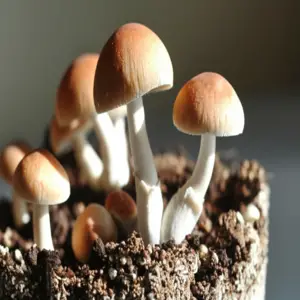
mushroom identification
2. Biocontrol Agents
Biocontrol agents are beneficial microorganisms that can help suppress fungal growth in the soil. Some gardeners are using products containing beneficial bacteria or fungi to create a healthier soil environment and prevent mushroom problems. Research into the effectiveness of different biocontrol agents for houseplant applications is ongoing.
3. Smart Watering Systems
Smart watering systems use sensors to monitor soil moisture levels and automatically water plants as needed. This can help prevent overwatering and create a more consistent growing environment. However, it’s important to choose a system that is compatible with your plant’s needs and to monitor the system regularly to ensure it’s functioning correctly.
4. Hydroponics and Semi-Hydroponics
Hydroponics and semi-hydroponics are growing methods that eliminate the need for soil altogether. In these systems, plants are grown in water or an inert medium like LECA, with nutrients added to the water. Since there is no soil, there is no risk of mushrooms growing. These methods are becoming increasingly popular for growing herbs and vegetables indoors, and some houseplant enthusiasts are also adopting them.
5. Increased Focus on Soil Health
There’s a growing understanding of the importance of soil health for plant growth. Gardeners are becoming more aware of the complex ecosystem that exists within the soil and the role of beneficial microbes in supporting plant health. This is leading to a greater emphasis on using soil amendments and other techniques to improve soil health and prevent disease.
Statistics on Houseplant Ownership and Related Issues
Here are some relevant statistics about houseplant ownership and related issues:
- Houseplant Ownership: According to a 2023 survey, approximately 70% of households in the United States own at least one houseplant. This number has been steadily increasing in recent years.
- Popularity of Indoor Gardening: The indoor gardening market is projected to reach $60 billion by 2027, driven by increasing consumer interest in houseplants and vertical farming.
- Common Houseplant Problems: Overwatering, underwatering, and pest infestations are the most common problems reported by houseplant owners.
- Fungal Diseases: Fungal diseases account for approximately 20% of houseplant problems.
- Impact of Pandemic: The COVID-19 pandemic led to a surge in houseplant ownership as people spent more time at home and sought to connect with nature.
Regulations Regarding Potting Soil and Plant Health
Regulations regarding potting soil and plant health vary by country and region. In general, these regulations are designed to prevent the spread of plant diseases and pests, and to ensure the quality and safety of potting soil. Here are some examples of relevant regulations:
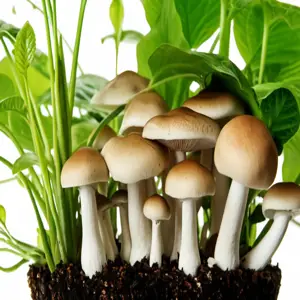
indoor plant mold
- Phytosanitary Certificates: Many countries require phytosanitary certificates for imported plants and potting soil to ensure they are free of pests and diseases.
- Soil Testing: Some regions require soil testing for certain contaminants, such as heavy metals, before potting soil can be sold.
- Pesticide Regulations: Regulations regarding the use of pesticides in potting soil and on plants vary widely. Some pesticides are banned or restricted in certain areas.
- Labeling Requirements: Potting soil labels are typically required to list the ingredients, volume, and other relevant information.
It’s important to be aware of the regulations in your area regarding potting soil and plant health. Contact your local agricultural extension office or regulatory agency for more information.
FAQ: Your Burning Mushroom Questions Answered
Still have questions about those unexpected fungal friends in your plant pots? Here are some frequently asked questions to help you understand and address the issue:
Are mushrooms in my houseplant soil dangerous to my plant?
Generally, no. The mushrooms themselves are not directly harmful to your plant. They are simply a sign that the soil is rich in organic matter and that the conditions are moist enough for fungal growth. The fungus is breaking down organic material in the soil, which can actually release nutrients that the plant can use. The main concern is the potential toxicity of the mushrooms to humans and pets.
How do I know if the mushrooms are poisonous?
Unless you are a trained mycologist, it’s impossible to be certain of the identification and safety of mushrooms growing in your houseplant soil. Never consume any mushrooms unless you are absolutely sure of their identification. If you suspect that a child or pet has ingested a mushroom, contact your local poison control center or veterinarian immediately.
Should I repot my plant if I see mushrooms?
Repotting can be a good solution if the mushroom problem is severe, or if the soil is old and compacted. Choose a well-draining potting mix and a pot with adequate drainage holes. When repotting, shake off as much of the old soil as possible and inspect the roots for any signs of rot or disease. If you don’t want to repot the entire plant, replacing the top few inches of soil can also be effective.
What is the white mold growing on the soil surface?
The white mold you see on the soil surface is likely a type of saprophytic fungus, similar to the ones that produce mushrooms. It is also a sign of excess moisture and organic matter in the soil. You can remove the mold manually, improve air circulation, and adjust your watering habits to prevent it from returning.
Can I use vinegar to kill the mushrooms?
While vinegar has antifungal properties, it can also be harmful to plants if used improperly. Diluted vinegar can be used as a soil drench, but it’s important to use it sparingly and to test it on a small area of the plant first to ensure it doesn’t cause any damage. A better option is to focus on improving drainage, air circulation, and watering habits.
Are coffee grounds good for houseplants?
Coffee grounds can be a beneficial soil amendment for some plants, as they contain nitrogen and other nutrients. However, they can also contribute to fungal growth if used in excess or if the soil is already too moist. Use coffee grounds sparingly and make sure they are well-composted before adding them to the soil. Also, be aware that coffee grounds can acidify the soil, so they are best suited for acid-loving plants.
Why are mushrooms growing in my succulent pot?
Mushrooms growing in a succulent pot are a sign that the soil is retaining too much moisture. Succulents prefer well-draining soil and infrequent watering. Make sure your succulent is planted in a well-draining cactus mix and that the pot has drainage holes. Allow the soil to dry out completely between waterings.
Can I use a hair dryer to dry out the soil?
Using a hair dryer to dry out the soil is not recommended. The hot air can damage the plant’s roots and leaves. A better option is to improve air circulation around the plant by placing it in a well-ventilated area or using a small fan.
How do I prevent fungus gnats?
Fungus gnats are small, annoying flies that thrive in moist soil and feed on fungi. To prevent fungus gnats, allow the top inch or two of soil to dry out completely between waterings. You can also use yellow sticky traps to catch adult gnats. A layer of sand or gravel on the soil surface can also help prevent gnats from laying their eggs in the soil. Introducing beneficial nematodes to the soil can also help control fungus gnat larvae.
Is it okay to leave the mushrooms alone if they aren’t hurting my plant?
While the mushrooms themselves may not be directly harmful to your plant, it’s generally best to remove them. They can be unsightly, and they pose a potential risk to children and pets if ingested. Furthermore, their presence indicates that the soil environment is not ideal, and addressing the underlying issues can improve your plant’s overall health.
Conclusion: Final Thoughts on Mushrooms and Houseplant Harmony
Discovering mushrooms sprouting in your houseplant’s soil can be a disconcerting experience, but it’s important to remember that it’s usually not a cause for major alarm. In most cases, the mushrooms are simply a sign of a thriving fungal ecosystem in the soil, which can even be beneficial to your plant. By understanding the factors that contribute to fungal growth – primarily excess moisture, rich organic matter, and poor drainage – you can take steps to create a less hospitable environment for mushrooms and prevent them from returning. Simple measures like adjusting your watering habits, improving drainage, and removing dead organic matter can often be enough to keep your plants healthy and mushroom-free.
The key takeaway is that maintaining a balanced and healthy soil environment is crucial for both preventing fungal growth and ensuring the overall well-being of your houseplants. While fungicides may seem like a quick fix, they can disrupt the delicate ecosystem of the soil and may not be necessary in most cases. Instead, focus on creating an environment that naturally discourages fungal growth while promoting the health of your plants. And remember, a little bit of vigilance and proactive care can go a long way in keeping your indoor garden thriving.
By addressing the underlying issues, you’re not just getting rid of the mushrooms; you’re improving the overall health and resilience of your plants, creating a happier and healthier indoor environment for both you and your green companions. Consider exploring more about soil compositions and amendments to improve your plant care knowledge and techniques. Also, learn about common houseplants pests to be prepared for all scenarios. With a little understanding and care, you can enjoy the beauty of your houseplants without the worry of unwelcome fungal guests.
Auto Amazon Links: No products found.
Wilt-Pruf® Christmas Tree/Cutting Preserver Spray |Preserves Christmas Trees, Wreaths, Garlands, Cuttings and Carved Pumpkins | Reduces Needle Drop | Keeps Cut Trees Fresh Longer | Natural (32 oz)
$21.99 (as of November 24, 2025 22:50 GMT +00:00 - More info- Product prices and availability are accurate as of the date/time indicated and are subject to change. Any price and availability information displayed on [relevant Amazon Site(s), as applicable] at the time of purchase will apply to the purchase of this product.
Perfect Plants Christmas Tree Saver 8oz. | Easy Use Xmas Tree Preserver Food | Have Healthy Green Christmas Trees All Holiday Season
$9.97 (as of November 24, 2025 22:50 GMT +00:00 - More info- Product prices and availability are accurate as of the date/time indicated and are subject to change. Any price and availability information displayed on [relevant Amazon Site(s), as applicable] at the time of purchase will apply to the purchase of this product.
Christmas Tree Watering Funnel – 39 Inch Adjustable 3-Section Design, Reusable & Spill-Free, Easy Watering for Real Christmas Trees
$10.70 (as of November 24, 2025 22:50 GMT +00:00 - More info- Product prices and availability are accurate as of the date/time indicated and are subject to change. Any price and availability information displayed on [relevant Amazon Site(s), as applicable] at the time of purchase will apply to the purchase of this product.
HoHoHoH2o Automatic Christmas Tree Watering System Device, Santa’s Tree Helper Keeps Your Christmas Tree Healthy and Fresh, Refillable 2.5 gallons Capacity Box - Red/Snowflakes
$99.95 (as of November 24, 2025 22:50 GMT +00:00 - More info- Product prices and availability are accurate as of the date/time indicated and are subject to change. Any price and availability information displayed on [relevant Amazon Site(s), as applicable] at the time of purchase will apply to the purchase of this product.
Automatic Christmas Tree Watering System | Reduce Needle Loss | Never Have a Dry Stand | Evergreen Helper® | US Patent 12,102,249
$28.49 (as of November 24, 2025 22:50 GMT +00:00 - More info- Product prices and availability are accurate as of the date/time indicated and are subject to change. Any price and availability information displayed on [relevant Amazon Site(s), as applicable] at the time of purchase will apply to the purchase of this product.
Zevo Flying Insect Trap Official Refill Cartridges - Fits Both Zevo Trap & MAX Indoor Fly Trap - Authentic Trap+Lock Technology to Catch Gnats, House & Fruit Flys (4 Official Refill Cartridges)
$14.97 (as of November 25, 2025 14:47 GMT +00:00 - More info- Product prices and availability are accurate as of the date/time indicated and are subject to change. Any price and availability information displayed on [relevant Amazon Site(s), as applicable] at the time of purchase will apply to the purchase of this product.
Traeger Grills Signature Blend 100% All-Natural Wood Pellets for Smokers and Pellet Grills, BBQ, Bake, Roast, 18 lb. Bag
$19.99 (as of November 25, 2025 14:47 GMT +00:00 - More info- Product prices and availability are accurate as of the date/time indicated and are subject to change. Any price and availability information displayed on [relevant Amazon Site(s), as applicable] at the time of purchase will apply to the purchase of this product.
TERRO Ant Killer Bait Stations T300B - Liquid Bait to Eliminate Ants - Bait System - 12 Count Stations for Effective Indoor Ant Control
$10.86 (as of November 25, 2025 14:47 GMT +00:00 - More info- Product prices and availability are accurate as of the date/time indicated and are subject to change. Any price and availability information displayed on [relevant Amazon Site(s), as applicable] at the time of purchase will apply to the purchase of this product.
Zevo Flying Insect Trap & 3 Refill Cartridges - Plug in Fly Trap & Indoor Bug Catcher for Gnats, House & Fruit Flies - Blue & UV Light Technology, Mess-Free Alternative to Bug Zapper
$25.96 (as of November 25, 2025 14:47 GMT +00:00 - More info- Product prices and availability are accurate as of the date/time indicated and are subject to change. Any price and availability information displayed on [relevant Amazon Site(s), as applicable] at the time of purchase will apply to the purchase of this product.
Victor Mouse Traps M150-12, Metal Pedal, Sustainably Sourced FSC Wood, Wooden Mouse Traps, 12 Metal Pedal Traps
$9.79 (as of November 25, 2025 14:47 GMT +00:00 - More info- Product prices and availability are accurate as of the date/time indicated and are subject to change. Any price and availability information displayed on [relevant Amazon Site(s), as applicable] at the time of purchase will apply to the purchase of this product.

